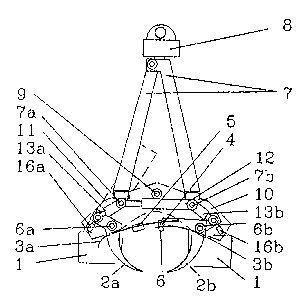Une partie des informations de ce site Web a été fournie par des sources externes. Le gouvernement du Canada n'assume aucune responsabilité concernant la précision, l'actualité ou la fiabilité des informations fournies par les sources externes. Les utilisateurs qui désirent employer cette information devraient consulter directement la source des informations. Le contenu fourni par les sources externes n'est pas assujetti aux exigences sur les langues officielles, la protection des renseignements personnels et l'accessibilité.
L'apparition de différences dans le texte et l'image des Revendications et de l'Abrégé dépend du moment auquel le document est publié. Les textes des Revendications et de l'Abrégé sont affichés :
| (12) Demande de brevet: | (11) CA 2115846 |
|---|---|
| (54) Titre français: | PINCE D'ABATTAGE POUR UNE ABATTEUSE D'ARBRES POLYVALENTE |
| (54) Titre anglais: | FELLING GRAPPLE FOR A MULTI-FUNCTION TREE HARVESTER |
| Statut: | Réputée abandonnée et au-delà du délai pour le rétablissement - en attente de la réponse à l’avis de communication rejetée |
| (51) Classification internationale des brevets (CIB): |
|
|---|---|
| (72) Inventeurs : |
|
| (73) Titulaires : |
|
| (71) Demandeurs : | |
| (74) Agent: | MARKS & CLERK |
| (74) Co-agent: | |
| (45) Délivré: | |
| (86) Date de dépôt PCT: | 1992-08-12 |
| (87) Mise à la disponibilité du public: | 1993-03-04 |
| Requête d'examen: | 1999-07-08 |
| Licence disponible: | S.O. |
| Cédé au domaine public: | S.O. |
| (25) Langue des documents déposés: | Anglais |
| Traité de coopération en matière de brevets (PCT): | Oui |
|---|---|
| (86) Numéro de la demande PCT: | PCT/FI1992/000227 |
| (87) Numéro de publication internationale PCT: | WO 1993003604 |
| (85) Entrée nationale: | 1994-02-16 |
| (30) Données de priorité de la demande: | ||||||
|---|---|---|---|---|---|---|
|
ABSTRACT OF THE DISCLOSURE
A felling, delimbing and cutting grapple for a multi-
function tree harvester. The grapple frame consists of two
support arms joined by a pin, the angle between the support
arms being set by a hydraulic actuator. One of the support
arms carries an upper delimbing cutter rigidly mounted to the
arm, while the other arm carries an upper delimbing cutter on
a hinge mounting, this delimbing cutter being guided by the
upper delimbing cutter. The lower delimbing cutters are
separately mounted on the support arms and by means of the
hinge pins and they are driven by the hydraulic actuators and
their postitions may be set through the hydraulic actuators
or through suitable machine elements, thus permitting the
cutters to be set at a distance from the trunk held in the
feed rollers during a delimbing operation.
Note : Les revendications sont présentées dans la langue officielle dans laquelle elles ont été soumises.
Note : Les descriptions sont présentées dans la langue officielle dans laquelle elles ont été soumises.

2024-08-01 : Dans le cadre de la transition vers les Brevets de nouvelle génération (BNG), la base de données sur les brevets canadiens (BDBC) contient désormais un Historique d'événement plus détaillé, qui reproduit le Journal des événements de notre nouvelle solution interne.
Veuillez noter que les événements débutant par « Inactive : » se réfèrent à des événements qui ne sont plus utilisés dans notre nouvelle solution interne.
Pour une meilleure compréhension de l'état de la demande ou brevet qui figure sur cette page, la rubrique Mise en garde , et les descriptions de Brevet , Historique d'événement , Taxes périodiques et Historique des paiements devraient être consultées.
| Description | Date |
|---|---|
| Demande non rétablie avant l'échéance | 2003-08-12 |
| Le délai pour l'annulation est expiré | 2003-08-12 |
| Réputée abandonnée - omission de répondre à un avis sur les taxes pour le maintien en état | 2002-08-12 |
| Inactive : Abandon. - Aucune rép dem par.30(2) Règles | 2002-07-16 |
| Inactive : Dem. de l'examinateur par.30(2) Règles | 2002-01-16 |
| Modification reçue - modification volontaire | 1999-11-03 |
| Lettre envoyée | 1999-07-16 |
| Inactive : Renseign. sur l'état - Complets dès date d'ent. journ. | 1999-07-16 |
| Inactive : Dem. traitée sur TS dès date d'ent. journal | 1999-07-16 |
| Exigences pour une requête d'examen - jugée conforme | 1999-07-08 |
| Toutes les exigences pour l'examen - jugée conforme | 1999-07-08 |
| Demande publiée (accessible au public) | 1993-03-04 |
| Date d'abandonnement | Raison | Date de rétablissement |
|---|---|---|
| 2002-08-12 |
Le dernier paiement a été reçu le 2001-07-27
Avis : Si le paiement en totalité n'a pas été reçu au plus tard à la date indiquée, une taxe supplémentaire peut être imposée, soit une des taxes suivantes :
Veuillez vous référer à la page web des taxes sur les brevets de l'OPIC pour voir tous les montants actuels des taxes.
| Type de taxes | Anniversaire | Échéance | Date payée |
|---|---|---|---|
| TM (demande, 5e anniv.) - petite | 05 | 1997-08-12 | 1997-07-28 |
| TM (demande, 6e anniv.) - petite | 06 | 1998-08-12 | 1998-07-23 |
| Requête d'examen - petite | 1999-07-08 | ||
| TM (demande, 7e anniv.) - petite | 07 | 1999-08-12 | 1999-08-06 |
| TM (demande, 8e anniv.) - petite | 08 | 2000-08-14 | 2000-08-11 |
| TM (demande, 9e anniv.) - petite | 09 | 2001-08-13 | 2001-07-27 |
Les titulaires actuels et antérieures au dossier sont affichés en ordre alphabétique.
| Titulaires actuels au dossier |
|---|
| JOUKO MOISIO |
| JUHA MOISIO |
| JUHA MOISIO |
| Titulaires antérieures au dossier |
|---|
| S.O. |